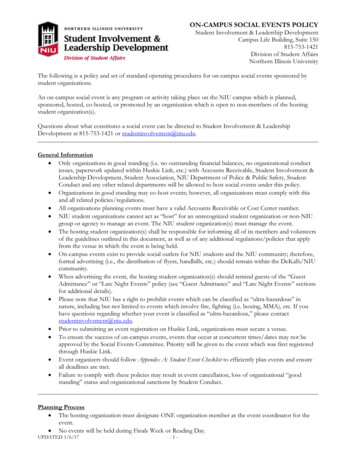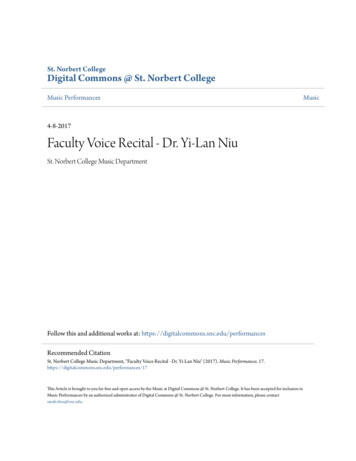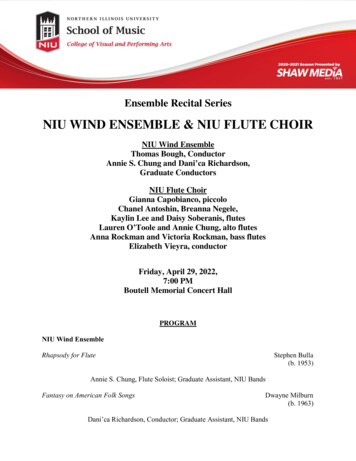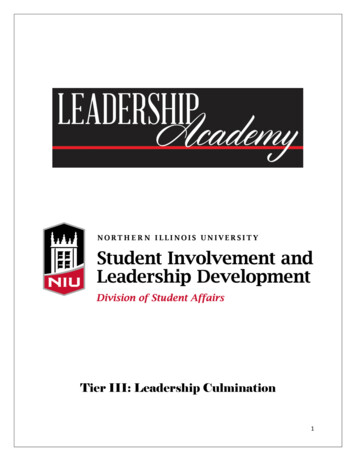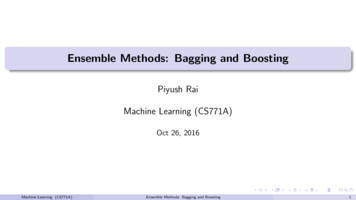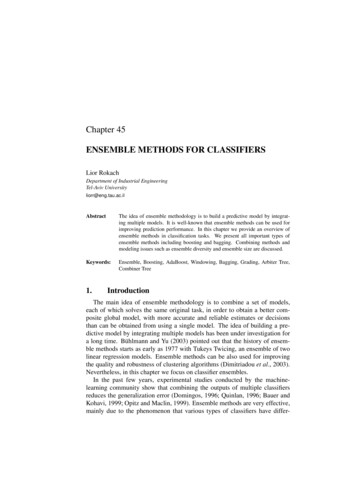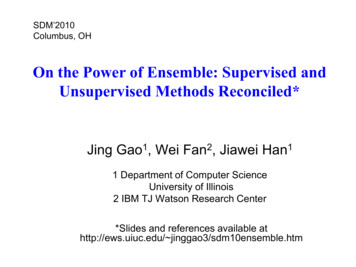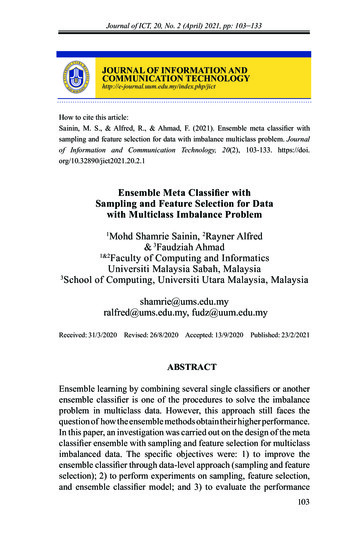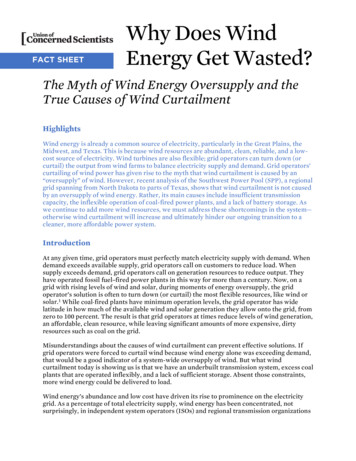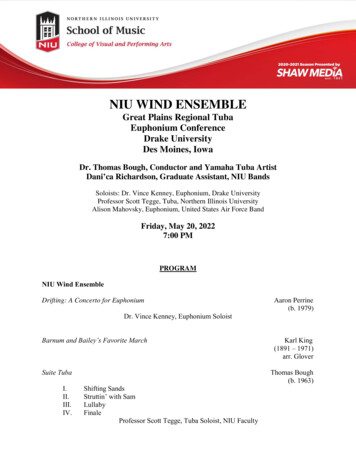
Transcription
NIU WIND ENSEMBLEGreat Plains Regional TubaEuphonium ConferenceDrake UniversityDes Moines, IowaDr. Thomas Bough, Conductor and Yamaha Tuba ArtistDani’ca Richardson, Graduate Assistant, NIU BandsSoloists: Dr. Vince Kenney, Euphonium, Drake UniversityProfessor Scott Tegge, Tuba, Northern Illinois UniversityAlison Mahovsky, Euphonium, United States Air Force BandFriday, May 20, 20227:00 PMPROGRAMNIU Wind EnsembleDrifting: A Concerto for EuphoniumAaron Perrine(b. 1979)Dr. Vince Kenney, Euphonium SoloistBarnum and Bailey’s Favorite MarchSuite TubaI.II.III.IV.Karl King(1891 – 1971)arr. GloverThomas Bough(b. 1963)Shifting SandsStruttin’ with SamLullabyFinaleProfessor Scott Tegge, Tuba Soloist, NIU Faculty
-Intermission-Fantasy on American Folk SongsDwayne Milburn(b. 1963)Dani’ca Richardson, conductor, Graduate AssistantConcerto for EuphoniumI.II.III.IV.Thomas Bough(b. 1968)AllegroLullabyDeep RiverDeep River FinaleAlison Mahovsky, Euphonium SoloistThe Melody ShopKarl King(1891-1971)
PROGRAM NOTESConcerto for EuphoniumAaron Perrine's Euphonium Concerto Drifting is the product of a commission consortium begunin 2020. Premiered in March of 2022, the piece is inspired by the North Shore of Lake Superiorand the composer's close connection to that area. The piece is also evocative of a Mary Oliverpoem by the same name, that reads:I was enjoying everything: the rain, the pathwherever it was taking me, the earth rootsbeginning to stir.I didn't intend to start thinking about God,it just happened.How God, or the gods, are invisible,quite understandable.But holiness is visible, entirely.It's wonderful to walk along like that,Thought not the usual intention to reach an answerbut merely drifting.Like clouds that only seem weightlessbut of course are not.Are really important.I mean, terribly important.Not decoration by any means.By next week the violets will be blooming.Anyway, this my delicious walk in the rain.What was it actually about?Think about what it is that music is trying to say.It was something like that.Barnum and Bailey’s Favorite MarchKarl King wrote “Barnum and Bailey’s Favorite” in 1913 just before joining the band as aeuphonium player. He was 22 years old at the time. By age 24, he had more than 150publications in print. This fast circus march, also known as a “screamer” became not only thesignature tune for the famous circus but for King as well. While traveling as a circus musicianwith his wife, he wrote music to match the rhythm of the various circus acts, which catapulted
him to leadership positions is some of the most famous circus bands of his day. King wrotemusic for the emerging school band movement as well and gave special attention to hiscompositions for younger players. To avoid the rigors of daily travel with the circus bands, hemoved his family to Fort Dodge, Iowa, where he took a position as conductor of the localmunicipal band. He quickly built the band to national prominence and took on a wider influencein the community as well. In particular, he helped formulate the Iowa Band Law which gavecities within the state the right to levy taxes specifically to support municipal bands andmusicians. Similar laws were passed in 28 other states, providing a legacy of music across theUnited States topped only by the popularity of King’s marches and other compositions.Suite TubaSuite Tuba was written in honor of my doctoral advisor and applied instructor from ArizonaState University, Sam Pilafian. Although Sam is best known in the brass world for his groundbreaking performances as the tuba player and founding member of the Empire Brass Quintet, hewas also the primary arranger and business manager for Empire for nearly 20 years. He is also anincredible teacher, who has trained thousands of musicians around the world. Sam had aprofound impact on my career in all four areas, that is, as a player, a composer and arranger,entrepreneur and teacher. This composition is designed to reflect different elements of trainingand studying with Sam.The first movement Shifting Sands reflects Sam’s love of rhythm and groove, not to mention thesands of the Sonoran Desert where we met. I know that Sam will appreciate the shiftingasymmetric rhythms of the first section, but I suspect he will enjoy the bass line thataccompanies the second section even more, since it extends over the bar line. In the secondsection, there are frequent shifts from major to minor and back again, which reflects the highlevel of technical fluency Sam expected, inspired and required. The second movement Struttin’with Sam reflects JSP’s remarkable skill as a jazz performer and teacher. In his undergraduatedays at the University Miami, Sam played bass guitar in the top jazz band alongside jazz legendsPat Metheny and Lyle Mays. His expertise in the field of early jazz performance was part ofwhat inspired my dissertation on the same topic. This movements starts with the soloist playingthe bass line, since bass line construction was a skill Sam passed on to all of us. This movementis loosely based on a traditional jazz tune called That’s a Plenty.The third movement Lullaby is self-descriptive. Sam talked about letting your sound “glow” inmusic like this, so that’s the goal .to play with a truly beautiful, resonant sound and let thesimplicity of the music speak for itself. As a tuba player, I always found it odd in a vague sort ofway that most of the solo literature was not actually written in the normal register for the tuba.As a conductor, I know why solo tuba parts get written so high, but in my own composition, Iwanted to keep at least a few phrases in the traditional range of the tuba. The duet with theFrench horn during the final full statement of the theme in this movement is the primary
exception to this concept. The final movement, subtitled Finale, combines themes from the othermovements with new material and a second cadenza.- Notes by Thomas BoughFantasy on American Folk SongsDwayne Milburn (b. 1963) is a native of Baltimore, Maryland. Upon graduation he became theDirector of Cadet Music for the United States Military Academy at West Point. Among his manyduties, he served as the conductor for the internationally renowned West Point Glee Club,leading that group in performances at some of the finest concert halls in the county, includingCarnegie Hall, Myerson Hall, and the Kennedy Center. During his studies in Cleveland, hecontributed several arrangements to the Cleveland Orchestra.Mr. Milburn is active as a composer, conductor, and adjudicator. His choral and wind ensemblecompositions are published by Alfred, Ludwig Masters, and the Neil A. Kjos Music Company.In addition to his duties as Composer-in-Residence for the St. Matthew’s Music Guild, his workshave been performed by some of the finest collegiate and professional ensembles in the nation.-Notes from the score“The piece grew out of my desire to continue introducing young musicians and audiences to therich heritage of our American folk music tradition. The folk songs featured in this compositionare probably among the better known and I enjoyed the opportunity to see how they might speakto me, and in turn, how I might speak to the performers and audiences alike.”-Dwayne MilburnConcerto for EuphoniumI am deeply grateful to the consortium sponsors who funded the creation of this music. DouglasRuby made the initial donation after a conversation at the 28th Annual U.S. Army Band TubaEuphonium Conference in Washington, DC in 2011. Bill Petersen and the band from FreeportHigh School joined Douglas as the other primary sponsor of this project. Many others joined inas well. The composition was completed in the summer of 2012.The music was inspired by the musical prowess of Dr. Demondrae Thurman, one of the greatesteuphonium soloists and chamber musicians of our time. The first movement was written to showoff his remarkable range and technique, couched in a setting of harmonic and rhythmic unrest.The contrasting modal theme of this movement was inspired by my daughter Rhea, who at theage of 6 made up fragments of this melody while in the back seat of the car serenading herfavorite blanket.
The second movement was inspired by two French-Canadian lullabies that Demondrae’s wifesang to his two children when they were small. The first, “Fais Do do” might be sung by an oldersibling rocking a baby to sleep while describing the household routine of the two parents. Thelovely melody matches the poignant scene of home and family that it describes. The second, “DoDo, l”enfant do” primarily urges the child to go to sleep, interspersed with some nonsense lyricsdescribing farm and neighborhood. Each lullaby is stated separately by the euphonium, thensuperimposed over each other by the soloist and band.The third movement is a traditional rendition of “Deep River”, based on Demondrae’s adaptationof this wonderful spiritual as performed on his compact disc “Songs of a Wayfarer”, publishedby Summit Records. By all means, listen to the warmth of sound and beautiful phrasingDemondrae pours into this incredible song that pleads for the comfort of a heart that is “overJordan”, referring to the ultimate salvation and resting place in eternity. To get an even bettersense of the emotional depth and fervency of this powerful piece of music, watch a video ofMarian Anderson or Mahalia Jackson singing this songThe final movement turns the longing portrayed in the traditional version of “Deep River” into atriumphant fanfare by moving to a major key, an energetic tempo, and adding a festive twist tothe melodic rhythm of the song. An abbreviated return of the thematic material of the firstmovement leads to a final cadenza followed by a final triumphant statement of the “Deep River”theme.The Melody ShopThe musical and practical heritage of the wind band is inexorably bound to the march. As such,we are pleased to close our program tonight with The Melody Shop. Karl King composed 185marches and more than 290 compositions. The Melody Shop was one of his earliest, published in1910 when the composer was only 19 years old. King had already composed several marchesand other works by this time, many of which were published by C. L. Barnhouse. Theeuphonium part in the final strain of this march has always been notorious for its difficulty,hence, it is often included on the required audition list for professional military bands and brassbands around the world. We are pleased to feature our euphonium section (and guests) on thismarch tonight.
BIOGRAPHICAL SUMMARIESDr. Thomas Bough joined the faculty of Northern Illinois University in the fall of 2005 as theDirector of Athletic Bands. He also conducts the Wind Ensemble and the Wind Symphony andteaches graduate conducting and instrumental arranging. Bough holds MM and DMA degrees inTuba Performance from Arizona State University, where he was a student of Sam Pilafian andDan Perantoni. He holds the degree Bachelor of Science in Music Education from Missouri StateUniversity, where he was active in both vocal and instrumental music. From 1999 – 2005 Boughserved as the Assistant Director of Bands and Professor of Tuba and Euphonium at SouthernIllinois University in Carbondale, Illinois, and from 1992 – 1999 as the Band Director atWestwood High School in Mesa, Arizona. He served as the founding conductor and musicdirector of the Fox Valley Brass Band in Aurora, Illinois from 2017 – 2021.Dr. Bough’s diverse performance background includes wind bands, brass bands, orchestras,chamber music, jazz bands, Dixieland, the Walt Disney World All American College Band andthe Phantom Regiment Drum and Bugle Corps. He is a Yamaha sponsored artist and performs onthe Yamaha 822 CC tuba and Yamaha 822 F tuba. In this capacity, he served as a brassconsultant and guest instructor with the Cavaliers Drum and Bugle Corps for six years. He wasalso an instructor with the Phantom Regiment Alumni Corps in 2016. Bough has contributednearly twenty articles and hundreds of new music reviews to the Instrumentalist magazine,School Band and Orchestra magazine, and DCI Today, as well as articles to five volumes of theTeaching Music Through Performance series as well as Teaching Music Through Performancein Jazz. In 2019, Bough was invited to partner with the Dansr Company as a Denis WickAmbassador.Dr. Bough is an active conductor, arranger, composer, clinician, and adjudicator for concertband, marching band, and brass band, with dozens of appearances per year to his credit acrossthe United States. His music is published by Alfred Publications, Cimarron Music and GPGPublications. He has served as a frequent masterclass clinician and/or conductor for the MusicFor All Summer Symposium and the Music For All National Concert Band Festival for overfifteen years. He has presented masterclasses at the Eastman School of Music, the Crane Schoolof Music, Arizona State University, the University of Michigan, the University of Toledo, andUNC-Greensboro, among many others. Bough has presented four times at the Midwest Clinicand twice at the U.S. Army Band Tuba-Euphonium Conference, as well as the InternationalSociety for Music Education Conference in Beijing, China, four NAFME multi-state regionalconventions, the International Horn Society Conference and the International Women’s BrassConference. In addition, he has presented at Music Educators Association State Conventions inIllinois, Arizona, Texas, Iowa, Tennessee, Alaska, Missouri, Kentucky, Ohio, Colorado,Nebraska, Arkansas, North Carolina, Indiana, New York, New Jersey, New Mexico, New York,South Carolina, Alabama, Georgia, Washington, Florida and the Texas BandmastersAssociation.
In May of 2014, his first compact disc was released, entitled, Concertos for Brass: The Music ofThomas Bough. This disc features three original concerti for solo brass instruments and windband, as well as a transcription of the Concerto in Eb by Neruda. It is available on the SummitRecords label at www.summitrecords.com. Since then, recent commissions have included “EsseQuam Videri” for Olivet Nazarene University, “Musings on Mahler” for Solo Trumpet andBand, “Legacy of Luther” for Concordia University in Chicago, “Air Mobility Fanfare” for theU.S. Air Force Band at Scott Air Force Base, “Poorest of the Poor: Music for Mother Teresa”,for the University of San Diego, “Fortress of Peace” for the Southwest Community ConcertBand, “Leviathan” for Hubble Middle School, and “Burn” for Alto Saxophone and Band,commissioned by Dr. Greg Dewhirst from Texas Wesleyan University.Learn more about his work at www.TomBough.com.Alison Mahovsky is a euphoniumist with the Ceremonial Brass, The United States Air ForceBand, Joint Base Anacostia-Bolling, Washington, D.C. A native of Burke, Virginia, her AirForce Career began in 2020. Alison completed her Bachelor of Music Education degree in 2013at The University of North Texas. She then went on to earn dual Masters Degrees in MusicEducation and Euphonium Performance at The University of North Texas. Her most influentialteachers are Jennifer Cox, Roger Behrend, and Dr. Brian Bowman. An accomplished soloist,Alison has received several international accolades. In 2010, she was the winner of The UnitedStates Air Force Band’s own George S. Howard Young Artist Competition. She was runner up inthe International Women’s Brass Conference’s Mock Audition competition in 2014, and in 2016Mahovsky was awarded a Bronze Medal in the Artist Division of the Leonard FalconeInternational Euphonium Competition.Dani’ca Richardson earned her Bachelor of Music degree from Eastern Illinois University inCharleston, IL, where she studied flute with Dr. Rebecca Johnson, conducting with Dr. AliciaNeal and music education with an instrumental concentration with Dr. Danelle Larson. Aftergraduating in 2015, she taught General Music with the Freeport School District, as well asOrchestra and Choir with Rockford Public Schools. Recently, Dani’ca worked withCharlottesville Opera (Charlottesville, VA) as their Assistant Maestra for their production of LaBohéme by Giacomo Puccini. Dani’ca is currently studying at Northern Illinois University withDr. Thomas Bough as she pursues her Master of Music degree with an emphasis in WindConducting.
Dr. Vince Kenney currently serves as Assistant Director of Bands/Assistant Professor of LowBrass at Drake University in Des Moines, IA, where he directs low brass studies and conductsthe Drake University Symphonic Band, Marching Band, and “Bulldog Brass” Pep Band.As a soloist and chamber musician, Vince has been invited to present guest artist recitals, clinics,and lectures, at dozens of the finest universities and music conferences throughout the UnitedStates, including the United States Army Band Tuba/Euphonium Workshop, the Texas MusicEducators Association All-State Conference (TMEA), the International Tuba/EuphoniumConference, the South Central, Midwest, and South East regional ITEA conferences, the IowaBandmasters Association, the Eastman School of Music, and many others. Dr. Kenney is acontributing author to the Teaching Music Through Performance in Band Series published byGIA, and his recording of James Curnow’s Euphonium Concerto on the Drake WindSymphony’s newest album “Tribute” received Grammy eligibility status for “Best ClassicalInstrumental Solo”.As a member of the North Texas Euphonium Quartet, Vince has helped to establish theeuphonium quartet as a viable chamber medium through performances, commissions, premieres,and educational outreach. To date, the group has aided in creating over 100 new works foreuphonium quartet along with a host of new arrangements. The group released their first album“Machines” in 2019.In 2020, Dr. Kenney was appointed music director and conductor of the Des Moines MetroConcert Band, Iowa’s only professional concert band. The group presents an annual Summerconcert series “Music Under the Stars – Iowa” on the steps of the Iowa State Capitol. Vince is amember of the College Band Directors National Association, The Iowa BandmastersAssociation, and the International Tuba Euphonium Association. He received undergraduatedegrees in Music Education and Performance from the University of Illinois, and Masters andDoctoral degrees in Euphonium Performance from the University of North Texas, under thetutelage of Dr. Brian Bowman. Dr. Kenney is a Willson performing artist, playing exclusively onthe Willson 2900-TA euphonium.Scott Tegge dedicates his career to the performance and expansion of repertoire for the tuba andbrass quintet, and to developing the next generation through his work as an educator.With a long-standing passion for chamber music, Scott has performed extensively in brassquintets since the age of fourteen, and founded his current ensemble, the Gaudete Brass Quintet,in 2004. (pronounced gow-day-tay.) Toward the goal of leaving future musicians robust andexpanded repertoire, Scott and the Gaudete Brass are particularly committed to commissioningoriginal works for brass, and have premiered more than fifty new works to date. Keeping arigorous touring schedule, the Gaudete Brass Quintet has performed at a variety of venuesincluding the Pritzker Pavilion at Millennium Park in Chicago, Symphony Space, Kaufman
Music Center, and Carnegie Hall in New York City. Gaudete Brass has also recorded criticallyacclaimed albums featuring many of their commissions and other original brass works.Scott has presented extensive educational programs, master classes, and concerts at The JuilliardSchool, Eastman School of Music, Arizona State University, University of Michigan, andVanderbilt University, as well as at numerous high schools and community music schools as partof the quintet’s touring activities.As an educator, Scott upholds three main performance principles: good sound, confidence, andartistic point-of-view. In his teaching, Scott helps students develop their own voices as musiciansthrough confidence building and self-directed learning. Believing that no music is worth makingif it does not sound good, he also emphasizes developing a solid technical foundation with hisstudents, focusing on good habits in breathing, phrasing, and dedication to fundamentals such aslong tones and scales. Scott builds a strong camaraderie among his students to support oneanother in taking performance risks and to learn how to play for each other and the public withconviction. Over time, they learn to play beyond the right notes toward interpretative musicmaking and performance.In addition to teaching tuba, euphonium, chamber music, and orchestral studies, Scott hasdeveloped methods to teach students how to think differently about a life in music, which he nowteaches as workshops and college courses on creative career building.Scott regularly freelances with a variety of orchestras in the Chicagoland area, and is a frequentspeaker and guest lecturer on inventive career development, entrepreneurship, and buildingsuccessful teaching studios.
WIND ENSEMBLE ROSTER*Principal PlayerFlute:Anna Rockman (piccolo) *Chanel AntoshinDaisy SoberanisLauren O’TooleOboe:Nicole Riordan *Bassoon:Hannah Kaspar *ClarinetKamil Lebowa *Kayla BivinAnthony DeveaMitchell LucasBass ClarinetDaniel BurkeSaxophone:Nicholas Haddock *, alto saxophoneNathan Tague, alto saxophoneDavid Patush, tenor saxophoneAaron Adams, baritone saxophoneHorns:Liam Weber *Ting-Yun WuBrooks WallaceBryan FlippinTrumpet:Amos Egleston *Phil PistoneAsa ValencianoJames MinardTrombone:Hannah Speer *Andrew WhitlockLiam Kantzler, bass tromboneEuphonium:Royce Pataras *Tuba:Elena Giglio*Jovanni LaPortePercussion:Jonathon Kurecki *Michael SpezialeEthan PattersonMorgan DudlicekPiano:Ting-Yun Wu
Dani ¶ca Richardson, Graduate Assistant, NIU Bands Soloists: Dr. Vince Kenney, Euphonium, Drake University Professor Scott Tegge, Tuba, Northern Illinois University Alison Mahovsky, Euphonium, United States Air Force Band Friday , May 20, 2022 7:00 PM PROGRAM NIU Wind Ensemble Drifting: A Concerto for Euphonium Aaron Perrine
